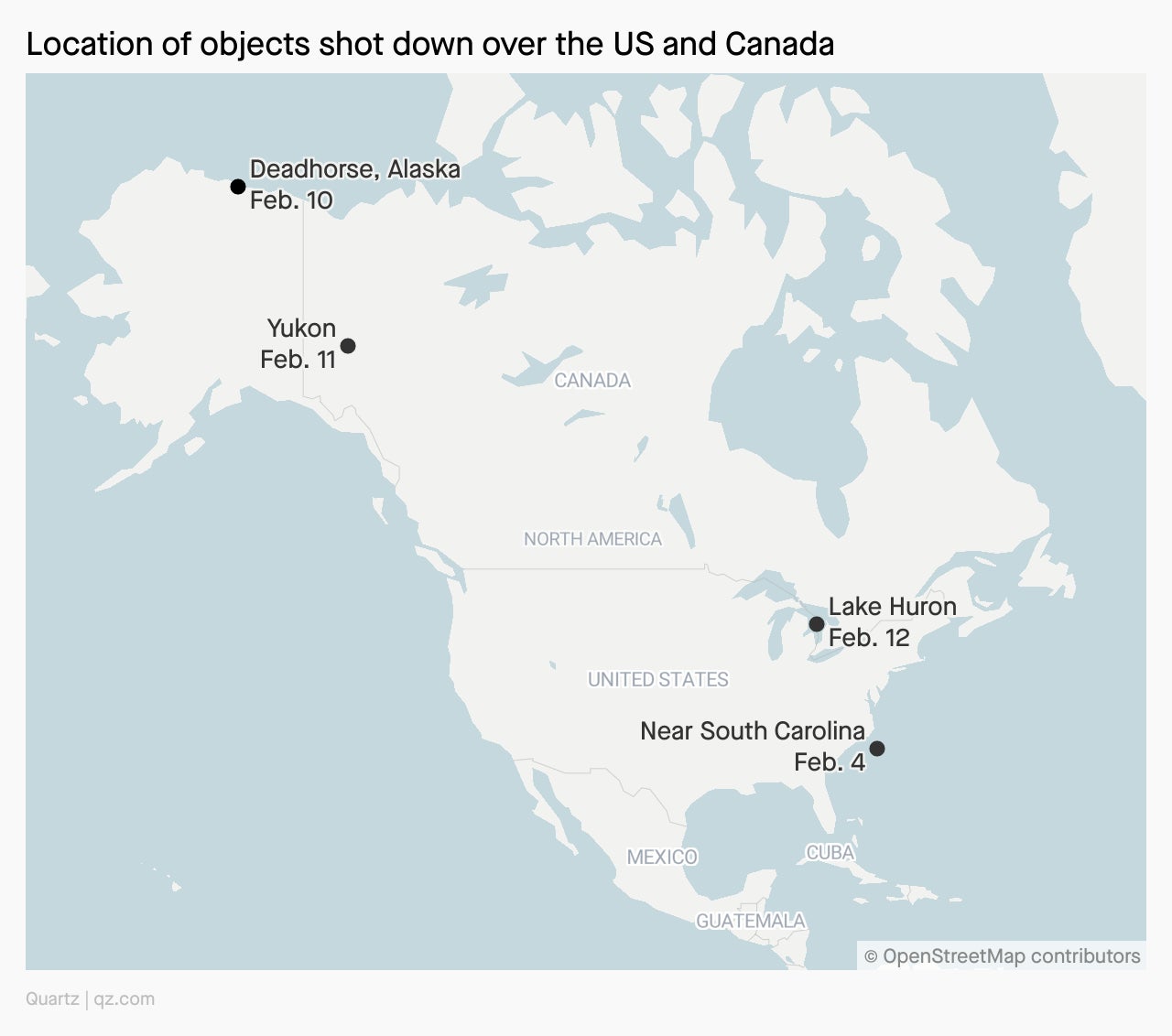Eyes in the sky
What's with all the foreign objects suddenly flying through US airspace?


Hi Quartz members!
The skies seemed empty—until suddenly they weren’t.
On Feb. 4, in the airspace over Montana, US planes shot down a giant white balloon, suspecting it to be a Chinese surveillance device. That was strange enough: a balloon in an age of hyper-fine satellite imagery? Then, over three days, the military shot down three more intruders over the US and Canada; one was the size of a small car, and another was small and cylindrical, according to the sparse details released. After that, China said it detected an unidentified object off its eastern coast, and accused the US of sending high-altitude balloons into Chinese airspace. The news, like a six-year-old’s birthday party, was full of balloons.

What explains this spate of aerial encounters? A Pentagon spokesperson said it was simply a result of watching the skies more closely in the wake of the first balloon incident, and of pre-emptively taking down unidentified objects near military installations or airline routes. And for them to occur in rapid succession was perhaps a “clustering illusion”—random events appearing as a “streak” only because the US was paying more attention. If you went out searching for suspicious flying things, they were there to be found.
But the authorities knew that, in a way. Last year, when the Office of the Director of National Intelligence published a report (pdf) on unexplained aerial phenomena, it examined 366 incident reports, 247 of which came from the 2021-22 period. Of the 366, 163 were “characterized as balloon or balloon-like entities,” the report said. At least 171 other incidents remained uncharacterized, and some of these “demonstrated unusual flight characteristics or performance capabilities.”
Nothing extraordinary in the fly-bys of the past two weeks, then—especially since US officials now believe that only the first balloon was intended to survey territories like Guam and Hawaii, and that the three other objects were not intended for surveillance. What’s new, though, is the heightened climate of tension in which these objects are being detected. The report’s 366 encounters all occurred before China’s saber-rattling over Taiwan in the summer of 2022, the Biden administration’s clutch of industrial policy laws designed explicitly to counter China, fresh US sanctions on China, and anxieties that Chinese apps like TikTok are being used to spy on Americans. Nerves are on edge, and brows furrowed with suspicion. In this fog of abundant mistrust, it’s little surprise that the US military, spooked by the big white balloon, is combing its airspace for other arrivals—and destroying them before they get very far.
WHY A BALLOON?
China has nearly 500 satellites orbiting the Earth. What could a surveillance balloon do that these satellites couldn’t? In his Quartz newsletter Space Business, senior reporter Tim Fernholz had an answer:
A country’s sovereign airspace theoretically extends to the (disputed) boundary with space. For China, something it might have done far more surreptitiously and legally in space became a diplomatic crisis when it used a balloon.
The key feature that government and independent observers cite for balloon surveillance is that it is far cheaper to put sensors on a high-altitude balloon than to launch them into space on a rocket, where they will be 20 times further from what they’re looking at or listening to. This is disruption, or what the US military might call an asymmetric threat.
Another benefit of using a balloon is higher-resolution imagery. An investor presentation of World View, an Arizona-based operator of high-altitude balloons, claims sensor resolutions of 3 to 5 cm per pixel, compared to the 50 cm per pixel resolution that is top of line in space-based Earth observation. The balloons also offer more persistent monitoring by floating above one location for weeks at a time, whereas Earth observation satellites can typically gather data a few times a day at most.
BALLOON FIGHTS
The US had (and possibly still has?) its own balloon espionage program, of course.
In the mid-1950s, the US military launched Project Genetrix, sending hundreds of 200-feet-tall balloons over China and the Soviet Union from sites in Norway, Scotland, and West Germany. The balloons were made by General Mills—now a company that owns Cheerios, Betty Crocker, and Häagen-Dazs, but then also an aeronautics and electronics giant. In a press conference, John Foster Dulles, then secretary of state, maintained that the balloons were measuring jet stream currents in the atmosphere.
The program didn’t last; the US managed to recover film from just 54 of its 512 balloons. But even these photographed more than a million square miles, a tenth of the area of China and the USSR. A report spelled out the benefits: “New targets were located, and confirmation of intelligence on previously known targets was possible.” The program faded away somewhat with the arrival of spy planes like the U2. But as recently as 2019, the US military was testing high-altitude balloons to “locate and deter narcotic trafficking and homeland security threats.”
The US has categorically denied Beijing’s charge of using balloons to spy on China. But as Gregory Poling, a security expert at the Center for Strategic and International Studies, told Reuters: “I suspect none of us would know for sure.” After all, nothing confirms the existence of a ballooning program as conclusively as a balloon that has been captured or shot down—and for US balloons, that hasn’t happened. Not yet, at any rate.
ONE 🚮 THING
If an object sailing through US airspace isn’t an active surveillance balloon, and if it isn’t a plane or a spaceship or a drone, chances are good that it’s just high-flying garbage.
It turns out that the skies above us, up to 25 miles (40 km) up, are home to plenty of errant junk. Roughly 1,800 meteorological balloons are launched around the world daily, according to the US National Weather Service; many of them fail to return to earth, blown around by atmospheric currents. Private companies use balloons as well. For a while, Google sent up so many as part of its Loon wireless internet project that FlightRadar24 had a special icon for them. Space debris sometimes slips into the upper atmosphere and then tumbles to the ground, as happened with parts of China’s Long March rocket last summer.
One of these artefacts could show up as an anomaly on radar systems and, in this charged climate, set off an alarmed investigation. We don’t often feel relieved when something turns out to be trash, but in the case of unidentified flying objects, trash is very much the best-case scenario.
QUARTZ STORIES TO SPARK CONVERSATION
- Ford’s EV battery deal with China’s CATL echoes industrial history
- The US should appoint a non-American to head the World Bank
- A new report suggests Pablo Neruda was poisoned in the aftermath of Chile’s 1973 coup
- Scottish leader Nicola Sturgeon’s resignation tilts world politics back toward a male enterprise
- What does Air India’s historic aircraft deal mean for the company—and for India?
- Here’s how 10 industries are experimenting with ChatGPT
- The cholera vaccine shortage could increase the toll of the earthquake in Syria and Turkey
5 GREAT STORIES FROM ELSEWHERE
🛢️ Slick promises. In recent weeks, the world’s biggest oil companies—BP, Exxon, Shell—have reported record-breaking profits. At the same time, they’ve discreetly rolled back widely touted commitments to reduce carbon emissions. As BP’s CEO baldly stated: “We’re going to be driven by value.” A piece from Grist looks at how geopolitics, policy incentives, and Big Oil’s profit calculus have fueled this oily change in tune.
🖼️ No shade. In the history of art, shadows are a slippery thing. Slinking briefly into existence in Roman art, and then disappearing again to only emerge in the Renaissance, there may be good reason for their intermittent presence in visual works. A story from MIT Press examines the odd, wayward, and altogether absent shadows in Western art, and what they can teach us about human perception.
💊 Where’s the pill? Contraception has long been a responsibility placed on women. Options abound: hormone implants, vaginal rings, intrauterine devices, female condoms, birth control pills, and the list goes on. But to date, the only two options available to men are condoms and vasectomies. The BBC explains why no male contraceptive pill exists on the market, although effective drugs have already been known for decades.
☕ The coffee chat. Maybe you’re familiar with this situation: An email pings in your inbox from someone you may or may not know, requesting if you can “chat and grab a coffee.” They might be asking for advice, or offer some vague notions about connecting. Do you take it? In an imaginary anecdote (that feels a little too real), The Economist advises there are probably better alternatives to these caffeinated encounters.
✈️ Soup fuel. Spicy hotpot, a classic dish from China’s southwestern province of Sichuan, is a meaty, soupy revelation. It’s also very greasy—the provincial capital of Chengdu produces 12,000 tons of used oil each month from hotpots alone. One enterprise has turned the waste into an opportunity. Bloomberg finds out how a Chinese startup is collecting leftover hotpot fat and shipping it abroad to be converted into jet fuel.
Thanks for reading! And don’t hesitate to reach out with comments, questions, or topics you want to know more about.
Fly high this weekend,
— Samanth Subramanian, global news editor; Tim Fernholz, senior reporter
Additional contributions by Julia Malleck and Amanda Shendruk